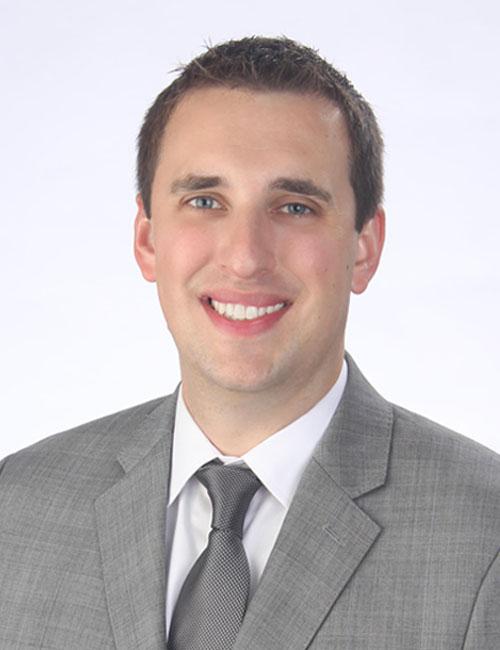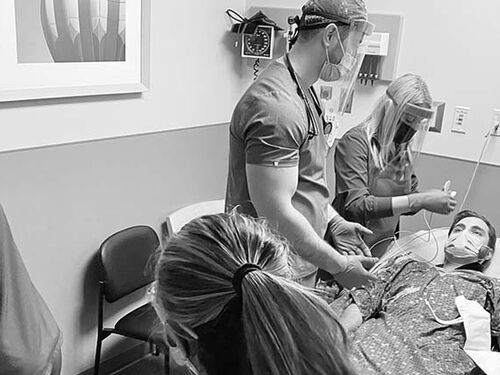ERs Rise to the Covid-19 Challenge: Teamwork between Engineers and Healthcare Providers Cuts ER Waiting Time
Perspectives
By guest contributor Brett Rungwerth and Kealoha Deutsch
Last update May 25, 2021
Perspectives offer practitioners, scholars, and policy leaders a platform to comment on developments and issues relating to engineering.
Brett Rungwerth is vice president of Performance Improvement – National Group; and Kealoha Deutsch is senior director of Performance Improvement – ER, West Florida Division, both at HCA Healthcare.


In 2020, surges of covid-19 patients challenged the ability of hospitals to manage the operation of their emergency rooms (ERs). At HCA Healthcare, we made fundamental changes to the processes used in our ERs. One important change streamlined the “patient intake” process, reducing the time between a patient’s arrival at an ER and visit with a physician or advanced-care practitioner from 10.5 minutes in January 2020 to 9.2 minutes in January 2021. That counterintuitive result in the midst of a global pandemic was made possible by systems engineering.While “normal” ER visits declined during the pandemic—people delayed or avoided them because they were afraid of being exposed to covid-19 at the hospital—the number of “serious” ER visits increased exponentially. HCA Healthcare ERs experienced a 55 percent increase in the number of patients who needed to be admitted to the hospital for further or more extensive treatment. At one point, about 20 percent of the treatment space in our ERs was occupied by those patients, a situation that challenged our ER staff and space.
A process redesign implemented at one hospital, with 350 inpatient beds and 29 ER beds, illustrates how system engineering enabled us to better navigate the challenges of the global pandemic. In August 2020 the number of covid-19 cases peaked in the community surrounding our hospital, resulting in a higher-than-normal volume of patients in the ER. To address this increase, we redesigned the ER process flow to
streamline patient assessment,
speed the assignment of patients to appropriate sites of care in the ER, and
implement parallel processing (“swarming”) for the sickest patients who arrived by EMS.
Essentially, it was a shift from serial to simultaneous workflows. The simultaneous or “swarm” process expedited the patient intake and treatment process by about 30 percent. It eliminated duplicative tasks, fostered communication and alignment among the ER staff, and helped to ensure that orders were fulfilled at the earliest possible point in the patient’s treatment. Specifically, the ER processes were reengineered as follows:
“Surge” beds were added to the ER and a QuickCare ER was set up in an adjacent space. These measures expanded ER capacity by 270 percent and increased the flexibility of ER staff to find the ideal place in the ER for their patients.
A triage nurse rapidly evaluated and prioritized patients upon their arrival to the ER; the sickest patients were directed to the ER immediately and others to the QuickCare ER for further assessment. This process eliminated the need for patients to wait in a lobby or for ER staff to talk with patients in the lobby.
A new “swarm” response enabled ER staff to work concurrently with the sickest patients to (1) take initial vital signs, (2) connect them to appropriate monitoring, (3) conduct a physical examination, and (4) discuss the plan of care.
* *
Kealoha DeutschERs operate under intense pressure, since actions there can determine life or death for some patients. In the context of a pandemic and the surges it creates, it is especially important that ERs have a process that enables staff to ascertain quickly each patient’s condition and the resources necessary for treatment.
In the midst of the covid-19 pandemic, HCA Healthcare drew on systems engineering principles that it had been hardwiring into its hospitals for more than 15 years. These principles are now a playbook for our hospitals, and a regionally based system engineer helps each hospital tailor the system to its staffing and patient needs. That combination has enabled HCA Healthcare to create an ER intake process that exceeds the industry norm: In 2019 patients visiting one of our ERs saw a physician or advanced-care practitioner within 10 minutes on average. In contrast, only 43.5 percent of patients nationally were seen within 15 minutes of arrival, according to the National Center for Health Statistics.
Our systems engineering approach incorporates the following considerations:
Staffing. Staffing plans can be flexed to accommodate patient mixes and traffic patterns. Data related to patient arrival patterns help identify days of the week and times of day, for example, that are more heavily trafficked. These data inform decisions about opening additional examination or treatment spaces.
Patient intake process. The ability to quickly assess patients during peak times allows ER staff to find the ideal place for their treatment. Staff can care for patients appropriately while ensuring that resources are available for acute patients brought to the ER by EMS. Retrospective sampling of patient records is used to check the reliability of our assessment process.
Immediate patient placement. Patients are moved immediately from the lobby to the ideal place in the ER for their treatment. The ER staff member who first assesses a patient accompanies the patient to the treatment area, to maintain continuity and to communicate, as needed, with the nursing or other staff who will continue the patient’s evaluation. Various staff members in the department need to be able to flex into that function if an unusual surge occurs. Staffing plans modeled on historical data are important to best align staffing with typical patient arrival patterns. The swarm process is designed to synchronize tasks for a more efficient process and to prevent lobby bottlenecks, for both patients and ER staff.
Lab and radiology support. Many ER patients require lab or imaging tests. Digital tracking is used to monitor patients’ treatment progress in real time and quickly identify patients who require transport for services such as radiology scans. ER staff can easily determine when test results are available.
Traffic control. Many of our ERs have a “traffic control” nurse during peak times to monitor these processes and to intervene if any components are not working as planned. These nurses use real-time trackers, which provide insights on each patient’s progress and overall situational awareness on the following:
– hospital resources, such as the availability of staff and treatment space;
– systems status, such as signaling that a lab analysis unit is offline; and
– overall patient flow performance indicators, such as how long it takes to see a physician or advanced-care provider.Space and layout. The playbook helped guide the setup and equipping of new treatment spaces necessitated by covid-19 patient surges, whether a coopted conference room with chairs or an exam room with a patient bed.
Real-time trackers not only monitor each patient’s progress but also provide situational awareness about
HCA Healthcare’s incorporation of systems engineering enabled us to make the rapid shifts necessary for patient care during the pandemic. As trained systematic problem solvers, engineers are skilled at evaluating processes, failure modes, and analytical techniques to guide design and operational decisions. This engineering approach was critical to supporting and even improving healthcare processes during a sustained period of exceptional demand, benefiting both patients and healthcare professionals.
Disclaimer
The views expressed in this perspective are those of the author and not necessarily of the author’s organizations, the National Academy of Engineering (NAE), or the National Academies of Sciences, Engineering, and Medicine (the National Academies). This perspective is intended to help inform and stimulate discussion. It is not a report of the NAE or the National Academies. Copyright by the National Academy of Sciences. All rights reserved.

